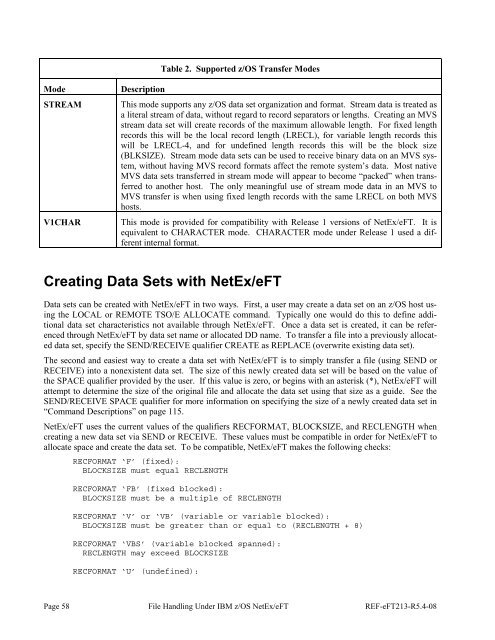NetEx EFT213 Reference Manual Rel 5.4
NetEx EFT213 Reference Manual Rel 5.4
NetEx EFT213 Reference Manual Rel 5.4
Create successful ePaper yourself
Turn your PDF publications into a flip-book with our unique Google optimized e-Paper software.
Table 2. Supported z/OS Transfer ModesModeSTREAMV1CHARDescriptionThis mode supports any z/OS data set organization and format. Stream data is treated asa literal stream of data, without regard to record separators or lengths. Creating an MVSstream data set will create records of the maximum allowable length. For fixed lengthrecords this will be the local record length (LRECL), for variable length records thiswill be LRECL-4, and for undefined length records this will be the block size(BLKSIZE). Stream mode data sets can be used to receive binary data on an MVS system,without having MVS record formats affect the remote system’s data. Most nativeMVS data sets transferred in stream mode will appear to become “packed” when transferredto another host. The only meaningful use of stream mode data in an MVS toMVS transfer is when using fixed length records with the same LRECL on both MVShosts.This mode is provided for compatibility with <strong>Rel</strong>ease 1 versions of <strong>NetEx</strong>/eFT. It isequivalent to CHARACTER mode. CHARACTER mode under <strong>Rel</strong>ease 1 used a differentinternal format.Creating Data Sets with <strong>NetEx</strong>/eFTData sets can be created with <strong>NetEx</strong>/eFT in two ways. First, a user may create a data set on an z/OS host usingthe LOCAL or REMOTE TSO/E ALLOCATE command. Typically one would do this to define additionaldata set characteristics not available through <strong>NetEx</strong>/eFT. Once a data set is created, it can be referencedthrough <strong>NetEx</strong>/eFT by data set name or allocated DD name. To transfer a file into a previously allocateddata set, specify the SEND/RECEIVE qualifier CREATE as REPLACE (overwrite existing data set).The second and easiest way to create a data set with <strong>NetEx</strong>/eFT is to simply transfer a file (using SEND orRECEIVE) into a nonexistent data set. The size of this newly created data set will be based on the value ofthe SPACE qualifier provided by the user. If this value is zero, or begins with an asterisk (*), <strong>NetEx</strong>/eFT willattempt to determine the size of the original file and allocate the data set using that size as a guide. See theSEND/RECEIVE SPACE qualifier for more information on specifying the size of a newly created data set in“Command Descriptions” on page 115.<strong>NetEx</strong>/eFT uses the current values of the qualifiers RECFORMAT, BLOCKSIZE, and RECLENGTH whencreating a new data set via SEND or RECEIVE. These values must be compatible in order for <strong>NetEx</strong>/eFT toallocate space and create the data set. To be compatible, <strong>NetEx</strong>/eFT makes the following checks:RECFORMAT ‘F’ (fixed):BLOCKSIZE must equal RECLENGTHRECFORMAT ‘FB’ (fixed blocked):BLOCKSIZE must be a multiple of RECLENGTHRECFORMAT ‘V’ or ‘VB’ (variable or variable blocked):BLOCKSIZE must be greater than or equal to (RECLENGTH + 8)RECFORMAT ‘VBS’ (variable blocked spanned):RECLENGTH may exceed BLOCKSIZERECFORMAT ‘U’ (undefined):Page 58 File Handling Under IBM z/OS <strong>NetEx</strong>/eFT REF-eFT213-R<strong>5.4</strong>-08















